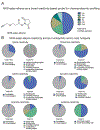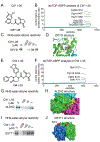NHS-Esters As Versatile Reactivity-Based Probes for Mapping Proteome-Wide Ligandable Hotspots
- PMID: 28445029
- PMCID: PMC7771572
- DOI: 10.1021/acschembio.7b00125
NHS-Esters As Versatile Reactivity-Based Probes for Mapping Proteome-Wide Ligandable Hotspots
Abstract
Most of the proteome is considered undruggable, oftentimes hindering translational efforts for drug discovery. Identifying previously unknown druggable hotspots in proteins would enable strategies for pharmacologically interrogating these sites with small molecules. Activity-based protein profiling (ABPP) has arisen as a powerful chemoproteomic strategy that uses reactivity-based chemical probes to map reactive, functional, and ligandable hotspots in complex proteomes, which has enabled inhibitor discovery against various therapeutic protein targets. Here, we report an alkyne-functionalized N-hydroxysuccinimide-ester (NHS-ester) as a versatile reactivity-based probe for mapping the reactivity of a wide range of nucleophilic ligandable hotspots, including lysines, serines, threonines, and tyrosines, encompassing active sites, allosteric sites, post-translational modification sites, protein interaction sites, and previously uncharacterized potential binding sites. Surprisingly, we also show that fragment-based NHS-ester ligands can be made to confer selectivity for specific lysine hotspots on specific targets including Dpyd, Aldh2, and Gstt1. We thus put forth NHS-esters as promising reactivity-based probes and chemical scaffolds for covalent ligand discovery.
Conflict of interest statement
The authors declare no competing financial interest.
Figures



Similar articles
-
Reimagining Druggability Using Chemoproteomic Platforms.Acc Chem Res. 2021 Apr 6;54(7):1801-1813. doi: 10.1021/acs.accounts.1c00065. Epub 2021 Mar 18. Acc Chem Res. 2021. PMID: 33733731 Review.
-
Activity-based protein profiling for mapping and pharmacologically interrogating proteome-wide ligandable hotspots.Curr Opin Biotechnol. 2017 Feb;43:25-33. doi: 10.1016/j.copbio.2016.08.003. Epub 2016 Aug 26. Curr Opin Biotechnol. 2017. PMID: 27568596 Free PMC article. Review.
-
[Advances in applications of activity-based chemical probes in the characterization of amino acid reactivities].Se Pu. 2023 Jan;41(1):14-23. doi: 10.3724/SP.J.1123.2022.05013. Se Pu. 2023. PMID: 36633073 Free PMC article. Review. Chinese.
-
Direct mapping of ligandable tyrosines and lysines in cells with chiral sulfonyl fluoride probes.Nat Chem. 2023 Nov;15(11):1616-1625. doi: 10.1038/s41557-023-01281-3. Epub 2023 Jul 17. Nat Chem. 2023. PMID: 37460812
-
Proteome-wide covalent ligand discovery in native biological systems.Nature. 2016 Jun 23;534(7608):570-4. doi: 10.1038/nature18002. Epub 2016 Jun 15. Nature. 2016. PMID: 27309814 Free PMC article.
Cited by
-
Proteome-Wide Fragment-Based Ligand and Target Discovery.Isr J Chem. 2023 Mar;63(3-4):e202200098. doi: 10.1002/ijch.202200098. Epub 2023 Feb 8. Isr J Chem. 2023. PMID: 38213795 Free PMC article.
-
α-Methylene-β-Lactone Scaffold for Developing Chemical Probes at the Two Ends of the Selectivity Spectrum.Chembiochem. 2021 Feb 2;22(3):505-515. doi: 10.1002/cbic.202000605. Epub 2020 Nov 11. Chembiochem. 2021. PMID: 32964640 Free PMC article.
-
Activity-Based Sensing: A Synthetic Methods Approach for Selective Molecular Imaging and Beyond.Angew Chem Int Ed Engl. 2020 Aug 10;59(33):13734-13762. doi: 10.1002/anie.201909690. Epub 2020 Apr 23. Angew Chem Int Ed Engl. 2020. PMID: 31605413 Free PMC article. Review.
-
A proteome-wide atlas of lysine-reactive chemistry.Nat Chem. 2021 Nov;13(11):1081-1092. doi: 10.1038/s41557-021-00765-4. Epub 2021 Sep 9. Nat Chem. 2021. PMID: 34504315 Free PMC article.
-
Advances in covalent drug discovery.Nat Rev Drug Discov. 2022 Dec;21(12):881-898. doi: 10.1038/s41573-022-00542-z. Epub 2022 Aug 25. Nat Rev Drug Discov. 2022. PMID: 36008483 Free PMC article. Review.
References
-
- Evans MJ, and Cravatt BF (2006) Mechanism-based profiling of enzyme families. Chem. Rev 106, 3279–3301. - PubMed
Publication types
MeSH terms
Substances
Grants and funding
LinkOut - more resources
Full Text Sources
Other Literature Sources
Research Materials
Miscellaneous

